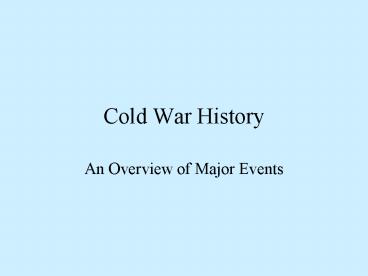Cold War History PowerPoint PPT Presentation
1 / 24
Title: Cold War History
1
Cold War History
- An Overview of Major Events
2
The post-war period two streams
- The end of European imperialism combined with the
growing sense that self-determination should be a
guiding principle in international politics led
to a tremendous wave of decolonization between
1945-1980. - The end of hostilities in 1945 also lead quickly
to a period of intense hostility between the U.S.
and Soviet Union (U.S.S.R.)
3
Decolonization
- The process of decolonization was relatively
peaceful in many cases it led to revolutionary
wars in others (e.g., Algeria). - The struggle for independence/national liberation
became embroiled in Cold War conflicts when the
superpowers and/or their allies became involved
(e.g. Vietnam).
4
Superpower confrontation
- There are disagreements about when the Cold War
started, why, and who was responsible. - Misperceptions?
- Inevitable?
- The Cold War started in Europe with the failure
to implement agreements reached at Potsdam and
Yalta. - Conferences focused on issues like free elections
and democratic institutions in Eastern Europe
(especially Poland) and the future of a divided
Germany.
5
The Cold War An Overview
6
Confrontation, 1945-1962
- Yalta Conference, 1945
- Soviet troops stationed throughout East Europe
- Stalin, Roosevelt, Chuchill
- How should the victorious powers manage Europe?
- Can the U.S.S.R. be stopped from overrunning
Europe?
7
Policy of Containment
- George Kennan
- Emphasized economic recovery in W. Europe
- Marshall Plan, 1947
- NATO, 1949
8
Revising Containment
- Public military displays by U.S.S.R. make Europe
nervous press U.S. for more security - NSC-68
- Most important revision of strategy of
Containment - Any substantial further extension of the area
under the domination of the Kremilin would raise
the possibility that no coalition adequate to
confront the Kremlin could be established
9
(No Transcript)
10
Korea
- First application of the new policy of
containment - Domino theory
- Resulted in U.S. military build-up in Europe
- End of WWI
- South occupied by U.S.
- North occupied by Soviets
- UN unable to hold elections in 1948
11
(No Transcript)
12
Korea
- U.S. and Soviet forces face off across the 38th
parallel - June 1950, North Korean Army attacks South Korea
13
Cuban Missile Crisis
- 1962 American spy planes spot rocket sites on
Cuba - Kennedy demands removal of missiles
- Russian ships approach Cuba
- U.S. orders naval quarantine of Cuba
- Crisis ends when Soviets agree to remove missiles
- Closest the superpowers came to nuclear war
14
From Coexistence to DétenteVietnam
- French imperial expansion into Indo-China
- Includes Laos and Cambodia
- After WWII
- Ho Chi Minh dominates north, including Hanoi
- French intended to recognize Ho Chi Minhs
republic north of the 18th parallel - Set up puppet regime South of Saigon
15
(No Transcript)
16
Vietnam
- 8 May 1953 France defeated at Bien Dien Phu
- Vietnam partitioned into North and South at the
17th parallel - Vietcong (North Vietnamese forces) attack south
- By 1963, ¼ of population of South Vietnam under
control of Northern forces - U.S. increases military support for South
- 1965, U.S. engaged in bombing North
- 1967, U.S. has 400,000 troops fighting
17
Nixon
- Failure of U.S. to gain victory in Vietnam forces
President Lyndon B. Johnson from office - Richard Nixon, who promised to bring the troops
back, takes office in 1968 - New political reality
- Soviets achieve nuclear parity
18
Detente
- Less confrontational policy
- Aimed at managing U.S.-Soviet relations through
negotiation - Carrots and Sticks
- Check Soviet expansion by forming alliances with
states that neighbored the U.S.S.R. - 1972 U.S. establishes diplomatic relations with
Communist China
19
Confrontation to Rapprochement
- The period of U.S.-Soviet détente is followed by
a period of renewed confrontation. - Second Cold War
- NATO agreed to deploy land-based Cruise and
Pershing II missiles in Europe if arms
negotiations with Soviets did not reduce serious
what was seen as a serious force imbalance.
20
Afghanistan
- December 1979, Soviet forces intervened in
Afghanistan to support its revolutionary allies. - Western powers denounced U.S.S.R.s actions,
leading U.S. President Jimmy Carter to change his
view of the Soviets. - 1980 U.S. Olympic boycott
21
Iran
- 1978, a series of protests erupts in Iran after
an inflammatory story about the exiled Ayatollah
Khoemeini is run in the official press. - American Embassy in Tehran captured. U.S.
Hostages held for 444 days (14 months). - Iranian leader, Shah (King) Mohammad Reza
Pahlavi, a staunch U.S. ally against the Soviets,
was eventually forced from power in January 1979.
Islamists take control.
22
Ronald Reagan Inaugurated
- In the midst of the Iran Hostage Crisis,
President Jimmy Carter loses his bid for
re-election to Ronald Reagan. - Reagan committed to a more confrontational
approach with the Soviets. - Initiates research on space-based missile defense
system (Star Wars).
23
The Soviet Leadership
- The early years of Reagans presidency involved
few high level contacts with Soviet leaders. - One problem three Soviet leaders (Brezhnev,
Andropov, and Chernenko) die in fairly rapid
succession
24
Glasnost and Perestroika
- Mikhail Gorbachev succeeded Chernenko and
instituted a program of limited reforms known as
Glasnost and Perestroika. - Glasnostopenness
- Perestroikarestructuring
- Gorbachev lost control of the reforms.
- Soviet Union collapsed in 1991.

